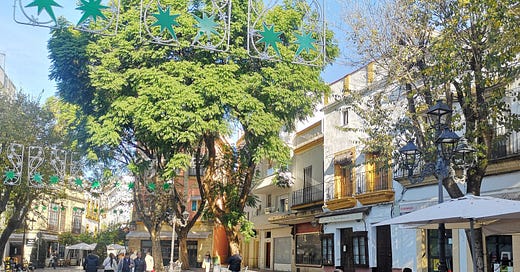This is a paid-subscriber-only post. Gain full access to everything Simple and Straightforward has to offer for $5 a month or $50 a year. We’re talking essays. We’re talking simple, waste-reducing recipes. We’re talking discussions and highly curated recommendations. It could be the best $5 you spend all month.
It’s a damp Friday night and the streets of Jerez in southern Spain are filled to bursting. All around is the clap-clap-clap of people tapping out Flamenco rhythms as they drink a beer. The sound of camareros (waiters) shouting orders to colleagues in the kitchen. And always at this time of year, the sound of the Zambomba - a traditional friction drum made from a clay pot, goat skin and rubber - keeping the rhythm going as thousands sing Flamenco-inspired Christmas carols in every square around town.
We enter a small bar, famous for its Flamenco. The bar staff greet us warmly - it’s not our first time in here.
No hay mucha gente Inglesa esta noche! - there are not many English in here tonight! - they joke with us as we order our sherries and take our usual spot close to the tiny little stage set up at the back of the bar.
There may not be many English, but there are scores of Spaniards eating jamón and montaditos - small sandwiches that are served in every bar around here.
As the Flamenco trio takes to the tiny stage — one singer, one dancer, and one guitarist — the room falls silent. They know what is about to happen.
The guitarist strums an impossible-looking palo — Flamenco song — as the performers begin their descent into an all-encompassing world where literally nothing else matters other than what is being sung, strung, and danced.
Flamenco is intense and tonight, it’s particularly so. The room is quiet. Hardly anyone — other than a couple of tourists — have their phones out. Even the bar staff have stopped what they are doing to watch.
The first time I watched Flamenco in this very bar back in 2015 — with these very performers — I had to leave in order to take big gulps of air as I bawled my eyes out in the little alleyway behind the bar, such was the emotion of the performance. I watched the same thing happen to my mother-in-law when she visited last week.
It’s what good Flamenco does to you. It makes you feel.
To become an excellent Flamenco artist, you have to be able to shut out all distractions. Your phone, the people around you, and everything that makes our modern world such a busy place - gone. You replace it with raw emotion and, if you’re lucky, Duende.
Keep reading with a 7-day free trial
Subscribe to This much I know to keep reading this post and get 7 days of free access to the full post archives.





